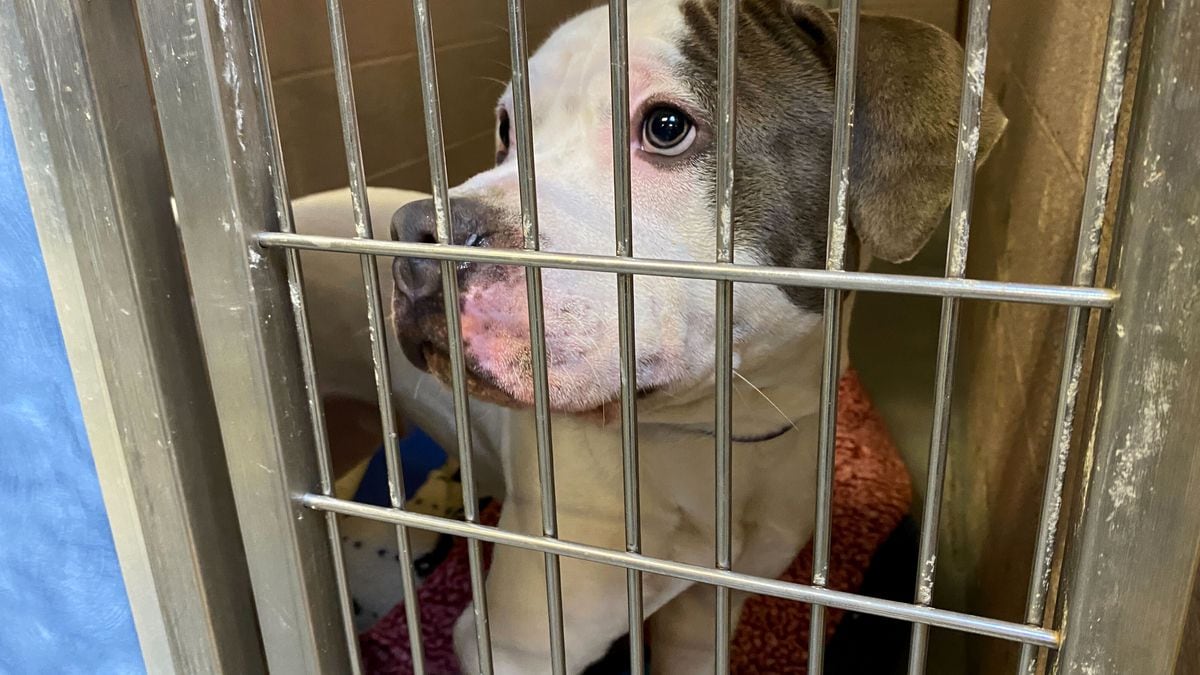Eroded trust, pandemic pressures pave long road ahead for Multnomah County animal shelter

This is the second part in a series of stories on failures at Multnomah County Animal Services. The first part outlining the breakdown of animal care is available here.
When staff at the Multnomah County Animal Services shelter saw that a Shiba Inu puppy made her way to their kennels in late 2021, they knew it wouldn’t take long to find a home.
Animal care manager Dean Alexander couldn’t wait. He brought the dog home as a foster the next day, according to county documents. He put her up for adoption three days after she came in — the minimum time the shelter has to wait before putting a stray up for adoption — and filed the paperwork to officially adopt her himself.
The Shiba Inu’s owners called the shelter the next day.
“They told me she was still there and I went to pick her up, but as soon as I got there, they lied and told me she was no longer there and wouldn’t even let me inside the building,” the puppy’s owner, who asked to remain anonymous, told OPB in a text message.

A Shiba Inu puppy was quickly adopted to a manager after she was brought into the Multnomah County Animal Services shelter in late 2021.
Multnomah County Animal Services public records
County records show the owner provided documents proving she owned the dog. Two days after her first visit to the shelter, her partner returned and demanded to speak to a manager.
A staff member in the shelter’s animal care division sent several text messages to the dog’s owner during the following days, encouraging her to pressure managers into returning her dog.
“Everyone at my shelter knows about this and me and several others are on your side,” the staff member wrote.
The incident was just one more example of a deep distrust that had festered between staff and managers of the Multnomah County shelter. Staffers saw managers like Alexander putting animal care as a lower priority than their own desires, and the divide had now burst into a dispute involving a pet owner.
Alexander eventually relinquished the dog and the shelter returned it to the owners. In an interview, Alexander denied any wrongdoing when it came to the valuable Shiba Inu puppy. He said other managers were verifying the pet owner’s paperwork during the five days that it took for them to relinquish the dog to its former owner.
“They weren’t really keeping me in the loop of what was really going on,” Alexander said.
Even though the Shiba Inu case resolved as staff wanted, the lack of trust it revealed — as well as significant industry pressures that are expected to grow in coming years — will be the most significant impasse to clear if the county wants to turn around well-documented struggles at the facility.
Conflicts and animal care
Public records obtained by OPB show workplace stress and distrust have been especially high among staff responsible for providing direct animal care, like cleaning kennels and feeding pets. Alexander has managed that division for three years.
Much of the conflict appears to come back to disagreements over the care animals receive. Since at least 2016, the shelter has struggled with high staff turnover, kennel overcrowding and inconsistent animal care, as outlined in an investigation by OPB.
Volunteers Kelley Sherman and Janice Then have criticized how managers limit their ability to interact with animals that could often benefit from attention in the stressful environment of a shelter. The pair said they’re not allowed to interact with dogs in the intake areas — where pets are kenneled before they can be listed for adoption — nor are they allowed to interact with “court dogs” in the high-security area. That’s where dogs who have bitten people or animals live during legal proceedings.
Dogs in Multnomah County’s high-security area don’t receive enrichment — staff don’t let them outside, and the only human contact they experience is being sedated for veterinary procedures. They often live in those conditions for months, sometimes years, before a hearings officer decides whether they should be euthanized due to aggressive behavior.
Such living conditions can often make dogs become more aggressive and agitated, and it can cause deteriorating physical health. County auditor Jennifer McGuirk validated the volunteers’ concerns in a 2018 report. She said she was disturbed by what she saw.
“Like dogs spinning in circles relentlessly, some really sad conditions for those dogs,” McGuirk said.
Dogs in the high-security area are considered to be too aggressive and dangerous for safe handling, but national animal care guidelines set by the Association of Shelter Veterinarians suggest dogs confined to enclosures still receive enrichment, such as food puzzle toys, classical music or a window to look outside.
“The shelter temporarily had an animal behaviorist who worked really hard to get those dogs access to the yard so that they could get outside, as well as bringing a TV to have some white noise,” McGuirk said.
By 2018, when the shelter used a grant to contract with Dogs Playing For Life to assess its operations, the behaviorist was gone. The corresponding report outlines similar solutions raised by the 2018 county audit. Many of those solutions appear to have gone unaddressed, including recommendations that the shelter improve its facility. The building itself, located in Troutdale, had previously served as the county jail. Dogs Playing For Life recommended the shelter add natural light to the high-security building, ensure all dogs have both indoor and outdoor access, and provide covering to play yards so dogs wouldn’t overheat.
A county spokesperson said the shelter had been developing plans to safely provide enrichment for dogs in the high-security area, but those plans died with the onset of the pandemic.
Though workers at the shelter repeatedly flagged animal care issues that festered in recent years, they say managers like Alexander ignored them. The conflicts were not limited to animal care, either.
Several former staff members told OPB that they quit their jobs due to the stressful work environment. They described a place where it was common to see staff cussing at each other in hallways, or crying over bullying and rumors. They said managers didn’t seem to care about their concerns and they weren’t interested in improving conditions at the shelter — either with animal care or interpersonal conflicts.

A screenshot from exit interview documents for an animal care technician who quit working at the Multnomah County animal shelter in April 2022.
Multnomah County Animal Services public records
During Alexander’s time heading the animal care division, at least two staffers accused him of making inappropriate comments and “leering” at women. The county conducted an internal investigation in early 2022 and substantiated a claim that Alexander had called a coworker “hot.” As a result, the shelter director at the time issued a “letter of expectation” to him.
During the investigation, Alexander denied making inappropriate comments or leering, adding that his staff often made these allegations after he reprimanded them for poor behavior, like leaving work early.
“Animal Services has … hired consultants because of the environment here,” Alexander said during an interview with an investigator in February 2022. “The personal dynamics … are very toxic. The way staff have treated each other … has been probably the single recurring theme that every staff member has come to [experience].”
He declined to comment on the allegations against him during an interview with OPB.
After the shelter reached a crisis point in January that led the county to temporarily halt taking in strays because of overcrowding, top managers promised better animal care and working conditions as they attempt to mend past grievances.
Still, those past wrongs may make the county shelter especially vulnerable to buckling in the future under immense pressure being put on animal shelters across the country.
Animal shelters in a tough spot
Animal shelters run by government agencies like Multnomah County have several key differences from those run by private or nonprofit organizations, such as the Oregon Humane Society in Portland. Their funding is reliant on taxpayer dollars and pet licensing fees, and they often don’t have much choice when accepting stray animals, even if those animals are aggressive or severely injured.
That environment can be stressful for workers, and it can become worse during a depressed economy.
“This is an outrageously stressful time for people involved in sheltering,” said Kim Casey, who manages Jackson County Animal Services in Southern Oregon.

A husky at the Multnomah County Animal Services shelter awaits adoption on Jan. 11, 2023, the first day the shelter allowed visitors to meet potential pets since the start of the pandemic. Troutdale, Ore.
April Ehrlich / OPB
Animal shelters are running short on support staff, particularly for low-level positions involved in direct animal care. In a 2021 survey of about 190 sheltering organizations by Best Friends Network, a nonprofit coalition of shelters, 87{95221ed7c1b18b55d17ae0bef2e0eaa704ccc2431c5b12f9d786c88d1acb538d} of respondents saw decreases in staffing and 75{95221ed7c1b18b55d17ae0bef2e0eaa704ccc2431c5b12f9d786c88d1acb538d} said the staff who remained were more stressed.
Casey, who has worked in municipal animal shelters for 30 years, said animal shelters have long struggled with retention in animal care positions because the work is both physically tedious and mentally exhausting. It’s difficult to care for pets and witness the daily tragedies of shelter work, from observing incoming abused animals to forming bonds with dogs or cats that are later euthanized.
A national worker shortage has made shelter worker retention worse. Casey said animal shelters are competing with restaurants, grocery chains and companies with work-from-home positions to offer better pay and benefits — something that’s difficult to do under a tax-funded government structure.
“I don’t have the ability to offer somebody a different salary based on what they would like to be paid,” Casey said. “We have a pay structure and a union that limit that ability.”
Shelters are also running against a nationwide veterinary worker shortage. Since the pandemic, veterinarians and veterinary technicians have left the field due to retirement, COVID-19 and burnout, while demand for veterinary services has grown.
“This is a national crisis,” said Sharon Harmon, Oregon Humane Society’s president and chief executive officer. “There is quickly becoming not enough veterinarians to meet the demand and not enough professional staff to support those veterinarians in their work.”
And the detrimental effects of the pandemic extend beyond the workforce. Animal intake has steadily increased since 2020. In Jackson County, Casey said she’s seeing an influx of kittens and puppies, which she attributes to the veterinary shortage: People are waiting months for their pets’ spay and neutering appointments, creating more time for inadvertent pregnancies.
People are also more likely to relinquish their pets during unstable economic times. The financial fallout resulting from the COVID-19 pandemic has worsened housing instability, particularly in Oregon, forcing some people to move into units with high pet fees or that don’t allow animals. Veterinary costs have also increased, leading to bills that some people can’t afford.
As a result of the high intake, some animal shelters — including in Jackson and Multnomah counties — have stopped accepting most pets surrendered by their owners, instead focusing their limited resources on animals reported as strays. Casey said this creates the potential for pets to become neglected or abused.
“If there is no place for them to go and people don’t have a resource, more animals are abandoned and more animals go without medical care,” Casey said.
To help people get care for their pets, some shelters and community leaders are focusing on a model called Human Animal Support Services, which targets services to keep people and pets together. Casey said the Jackson County shelter is in the first stages of implementing this new model.
“The central role of the shelter should be to provide support to the community to prevent animals that don’t need to be impounded from being impounded in the first place,” Casey said.
The project, run by a national program called American Pets Alive!, provides shelter partners with free training and resources on reducing the number of animals entering their kennels. It also has tips for community members who want to help.

A pitbull named Petey at the Multnomah County Animal Services shelter awaits adoption on Jan. 11, 2023, the first day the shelter allowed visitors to meet potential pets since the start of the pandemic.
April Ehrlich / OPB
Multnomah County wasn’t prepared
In Southern Oregon, the Jackson County Animal Shelter hasn’t been immune to the challenges facing Multnomah County. Casey said she has also struggled with hiring workers, high veterinary costs and high animal intake.
But Jackson County made key decisions that helped it manage, such as getting its adoption floor open to the public as quickly as possible after the pandemic began, a move that has allowed the shelter to oversee about the same number of dogs as Multnomah County with about a quarter of the staff. It also has found ways to sterilize and vaccinate all animals before they leave the shelter.
Casey said a robust volunteer base has helped it weather the storm currently overwhelming Multnomah County.
“We’re lucky,” Casey said. “If we didn’t have that volunteer support, then we would definitely struggle to have staff resources to continue to allow people to walk through the kennels.”
The Jackson County shelter receives volunteer help and some financial support from a separate nonprofit called Friends of the Animal Shelter. That group manages social media profiles to help animals get adopted sooner and share pet-care resources with followers.
Multnomah County leaders say they are taking swift action to ensure changes at a shelter that has been adrift for years.
In a press release Tuesday, Multnomah County Chair Jessica Vega Pederson said she is “determined to uncover the root of the issues we’ve faced at Animal Services and address them productively and proactively.” Pederson outlined a process for reviewing the division in the coming weeks, as well as the three past audits that gave the shelter failing marks for animal care and staff dynamics.
“I appreciate the deep investment of the animal care community in helping us move our work forward in coming weeks and look forward to providing more information following this review about medium- to long-term changes we’ll put in motion,” she wrote.
County auditors are also preparing to conduct another audit of the shelter later this year.
Shelter director Erin Grahek said so far, she’s hearing positive feedback from workers.
“We still have a long way to go, to improve policies and procedures, but we are making progress and committed to doing the work and getting there in partnership with our staff, volunteers, and concerned community members,” she wrote in an email.
McGuirk, the county auditor who reviewed the shelter before, said she wishes county leaders acted sooner to ensure the facility was more prepared for the extreme challenges the industry now faces.
“I’ve been disappointed about the lack of action by county management to bring animal services into compliance with national standards for animal shelters,” McGuirk said.
McGuirk added that Multnomah County is one of the few county departments that regularly hires leaders who don’t have direct experience in their field.
“I think it’s been concerning that people with limited or no animal care expertise have been directing the shelter,” she said.

At center, from left, Multnomah County Animal Services operations manager Marian Cannell and director Erin Grahek speak to reporters about reopening the shelter floor to the public on Jan. 11, 2023, at the shelter facility in Troutdale, Ore.
April Ehrlich / OPB
Grahek has been leading the shelter since July, after having worked in the county’s Aging Disability & Veteran Services department for about 23 years. She said her experience managing county programs makes her qualified to lead the shelter.
McGuirk has called on the Animal Services department to comply with standards set by the Association of Shelter Veterinarians, which says shelters must be led by someone who has the appropriate knowledge and training.
“We need to make sure that the person who is directing Animal Services meets that bare minimum,” McGuirk said. “I think that would be helpful to bring them into compliance, because that person would have some expertise in knowing how to do that.”
For now, Grahek has the backing of the top county leader and managers at the shelter, who say she’s already made notable changes. Staff, meanwhile, say they’re willing to trust her on the new direction — if they feel the county is ready to listen.
Clarification: This story has been updated to clarify that the Multnomah County animal shelter had a dog behaviorist on staff during its first audit in 2016. It later contracted with Dogs Playing For Life in 2018, which found the shelter no longer had a behaviorist.






